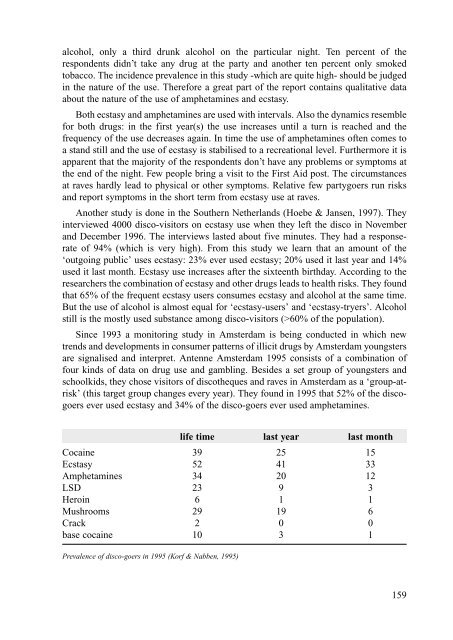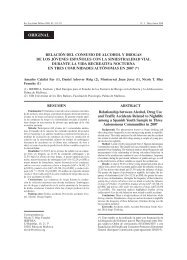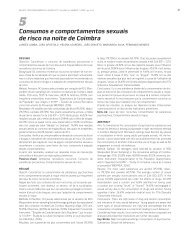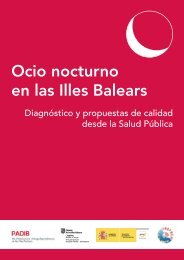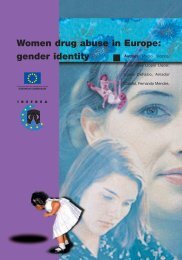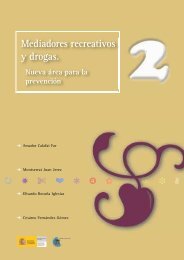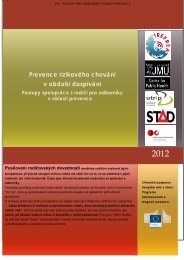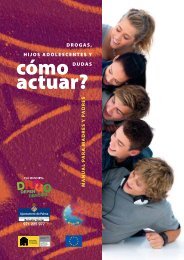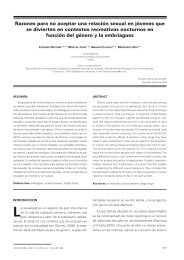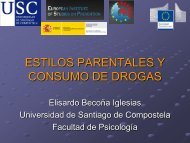Characteristics and social representation of ecstasy in Europe - Irefrea
Characteristics and social representation of ecstasy in Europe - Irefrea
Characteristics and social representation of ecstasy in Europe - Irefrea
Create successful ePaper yourself
Turn your PDF publications into a flip-book with our unique Google optimized e-Paper software.
alcohol, only a third drunk alcohol on the particular night. Ten percent <strong>of</strong> therespondents didn’t take any drug at the party <strong>and</strong> another ten percent only smokedtobacco. The <strong>in</strong>cidence prevalence <strong>in</strong> this study -which are quite high- should be judged<strong>in</strong> the nature <strong>of</strong> the use. Therefore a great part <strong>of</strong> the report conta<strong>in</strong>s qualitative dataabout the nature <strong>of</strong> the use <strong>of</strong> amphetam<strong>in</strong>es <strong>and</strong> <strong>ecstasy</strong>.Both <strong>ecstasy</strong> <strong>and</strong> amphetam<strong>in</strong>es are used with <strong>in</strong>tervals. Also the dynamics resemblefor both drugs: <strong>in</strong> the first year(s) the use <strong>in</strong>creases until a turn is reached <strong>and</strong> thefrequency <strong>of</strong> the use decreases aga<strong>in</strong>. In time the use <strong>of</strong> amphetam<strong>in</strong>es <strong>of</strong>ten comes toa st<strong>and</strong> still <strong>and</strong> the use <strong>of</strong> <strong>ecstasy</strong> is stabilised to a recreational level. Furthermore it isapparent that the majority <strong>of</strong> the respondents don’t have any problems or symptoms atthe end <strong>of</strong> the night. Few people br<strong>in</strong>g a visit to the First Aid post. The circumstancesat raves hardly lead to physical or other symptoms. Relative few partygoers run risks<strong>and</strong> report symptoms <strong>in</strong> the short term from <strong>ecstasy</strong> use at raves.Another study is done <strong>in</strong> the Southern Netherl<strong>and</strong>s (Hoebe & Jansen, 1997). They<strong>in</strong>terviewed 4000 disco-visitors on <strong>ecstasy</strong> use when they left the disco <strong>in</strong> November<strong>and</strong> December 1996. The <strong>in</strong>terviews lasted about five m<strong>in</strong>utes. They had a responserate<strong>of</strong> 94% (which is very high). From this study we learn that an amount <strong>of</strong> the‘outgo<strong>in</strong>g public’ uses <strong>ecstasy</strong>: 23% ever used <strong>ecstasy</strong>; 20% used it last year <strong>and</strong> 14%used it last month. Ecstasy use <strong>in</strong>creases after the sixteenth birthday. Accord<strong>in</strong>g to theresearchers the comb<strong>in</strong>ation <strong>of</strong> <strong>ecstasy</strong> <strong>and</strong> other drugs leads to health risks. They foundthat 65% <strong>of</strong> the frequent <strong>ecstasy</strong> users consumes <strong>ecstasy</strong> <strong>and</strong> alcohol at the same time.But the use <strong>of</strong> alcohol is almost equal for ‘<strong>ecstasy</strong>-users’ <strong>and</strong> ‘<strong>ecstasy</strong>-tryers’. Alcoholstill is the mostly used substance among disco-visitors (>60% <strong>of</strong> the population).S<strong>in</strong>ce 1993 a monitor<strong>in</strong>g study <strong>in</strong> Amsterdam is be<strong>in</strong>g conducted <strong>in</strong> which newtrends <strong>and</strong> developments <strong>in</strong> consumer patterns <strong>of</strong> illicit drugs by Amsterdam youngstersare signalised <strong>and</strong> <strong>in</strong>terpret. Antenne Amsterdam 1995 consists <strong>of</strong> a comb<strong>in</strong>ation <strong>of</strong>four k<strong>in</strong>ds <strong>of</strong> data on drug use <strong>and</strong> gambl<strong>in</strong>g. Besides a set group <strong>of</strong> youngsters <strong>and</strong>schoolkids, they chose visitors <strong>of</strong> discotheques <strong>and</strong> raves <strong>in</strong> Amsterdam as a ‘group-atrisk’(this target group changes every year). They found <strong>in</strong> 1995 that 52% <strong>of</strong> the discogoersever used <strong>ecstasy</strong> <strong>and</strong> 34% <strong>of</strong> the disco-goers ever used amphetam<strong>in</strong>es.life time last year last monthCoca<strong>in</strong>e 39 25 15Ecstasy 52 41 33Amphetam<strong>in</strong>es 34 20 12LSD 23 9 3Hero<strong>in</strong> 6 1 1Mushrooms 29 19 6Crack 2 0 0base coca<strong>in</strong>e 10 3 1Prevalence <strong>of</strong> disco-goers <strong>in</strong> 1995 (Korf & Nabben, 1995)159


